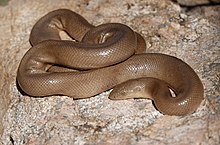| Charina | |
|---|---|

| |
| Rubber boa, C. bottae | |
| Scientific classification | |
| Domain: | Eukaryota |
| Kingdom: | Animalia |
| Phylum: | Chordata |
| Class: | Reptilia |
| Order: | Squamata |
| Suborder: | Serpentes |
| Family: | Boidae |
| Subfamily: | Erycinae |
| Genus: | Charina Gray, 1849 |
| Synonyms[1] | |
Charina is a genus of nonvenomous boas, commonly known as rubber boas, found in North America. Two species are currently recognized.[2]
Distribution and habitat
[edit]Found in North America from western Canada south through the western United States into northwestern Mexico.[1]
Species
[edit]| Species[2] | Taxon author[2] | Subsp.*[2] | Common name[2] | Geographic range |
|---|---|---|---|---|
C. bottaeT |
(Blainville, 1835) | 0 | Northern rubber boa | Western Canada in southeastern British Columbia. The northwestern and western United States in most of Washington, Oregon, Idaho, western Montana and Wyoming, northern and central Utah, and as far south as northern Nevada and Monterey County, California.[1][3] |
C. umbratica |
Klauber, 1943 | 0 | Southern rubber boa | The United States in southern California (Riverside and San Bernardino Counties).[3] |
- ) Not including the nominate subspecies.
T) Type species.[1]
Taxonomy
[edit]Sources vary on how many species the genus contains. Some consider the rubber boa, C. bottae, to be the sole member of the genus. In addition, some experts consider the southern rubber boa, C. umbratica to be a subspecies of C. bottae. Although the Calabar python, Calabaria reinhardtii has been included in Charina, recent phylogenetic analyses based on DNA have shown that it does not belong to this genus.[4]
References
[edit]- ^ a b c d McDiarmid RW, Campbell JA, Touré T (1999). Snake Species of the World: A Taxonomic and Geographic Reference, Volume 1. Washington, District of Columbia: Herpetologists' League. 511 pp. ISBN 1-893777-00-6 (series). ISBN 1-893777-01-4 (volume).
- ^ a b c d e "Charina". Integrated Taxonomic Information System. Retrieved 25 July 2022.
- ^ a b Wright AH, Wright AA (1957). Handbook of Snakes of the United States and Canada. 2 volumes. Comstock Publishing Associates, a division of Cornell University Press. (7th printing, 1985). 1,105 pp. ISBN 0-8014-0463-0. (Genus Charina, p. 53).
- ^ Pyron, R. Alexander; Burbrink, Frank T.; Wiens, John J. (2013). "A phylogeny and revised classification of Squamata, including 4161 species of lizards and snakes". BMC Evolutionary Biology 13: 93.
Further reading
[edit]- Gray JE (1849). Catalogue of the Specimens of Snakes in the Collection of the British Museum. London: Trustees of the British Museum. (Edward Newman, printer). xv + 125 pp. (Charina, p. 113).
- Kluge AG (1993). "Calabaria and the phylogeny of erycine snakes". Zoological Journal of the Linnean Society 107: 293–351. PDF at University of Michigan Library. Accessed 20 July 2008.
External links
[edit]Wikimedia Commons has media related to Charina.
- Calabaria reinhardtii at the Reptarium.cz Reptile Database. Accessed 6 July 2007.
- Charina bottae at the Reptarium.cz Reptile Database. Accessed 6 July 2007.
- Lichanura trivirgata at the Reptarium.cz Reptile Database. Accessed 6 July 2007.
- Charina at Life is Short, but Snakes are Long